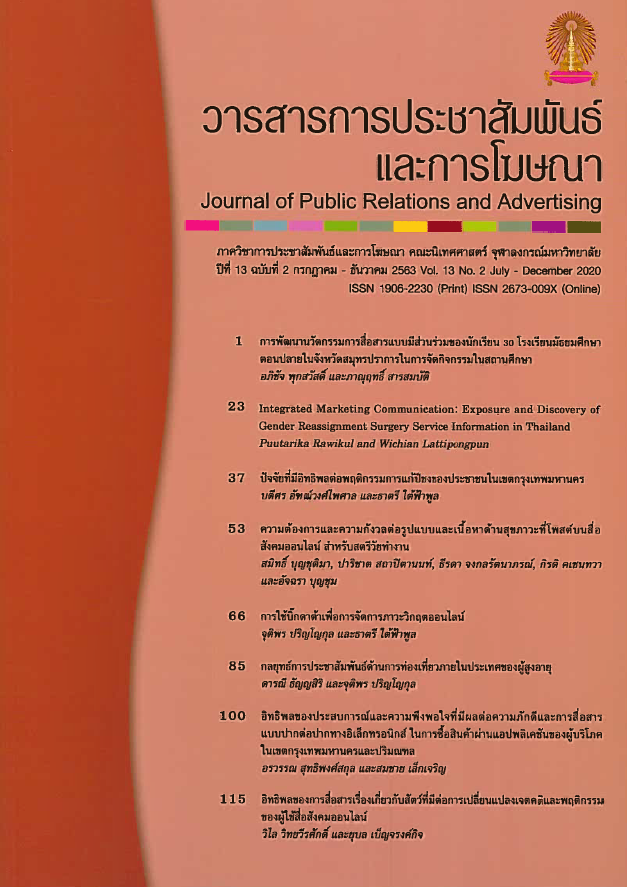Big Data for Online Crisis Management
Main Article Content
Abstract
Using big data as a tool for online crisis management is phenomenon that occurs under a new communication context. This article focuses on how big data impacts to online crisis management. The study found that data analysis with big data can help the organization to prevent and manage the organization's crisis. The implementation of big data in crisis management is an integration between science and communication knowledge, which has the advantage of being able to use information related to organizations and stakeholders that are produced from various sources to analyze situations, predictions and prescription. Enabling the organization to see the trend of crisis and can make decisions to resolve crises more accurately. But big data may create problems for the organization as well; the accuracy of the data, the ability to design tools for selecting data and analyzing results, the organization's readiness to deal with big data, the challenge of using Big Data to ethics and law and the use of Big Data to deal with crisis cannot be done without human.
Therefore, relevant organizations or agencies should pay more attention to human resource development that is capable of dealing with crisis and computer science capabilities together. Its will help reduce the gap and be the best solution.
Keywords: Crisis management, Online crisis management, Big data, Data analytic
Article Details
References
การรับฟังความคิดเห็นกฎหมายไทย. (2561). ร่างพระราชบัญญัติคุ้มครองข้อมูลส่วนบุคคล พ.ศ. ... (รับฟังความคิดเห็นระหว่างวันที่ 5 - 20 กันยายน 2561). วันที่เข้าถึงข้อมูล 22 มกราคม 2562 .แหล่งที่มา http://lawamendment.go.th/index.php/component/k2/item/1297-5-20-2561
กู้ด แฟคทอรี่. (2559). Big Data คืออะไร. วันที่เข้าถึงข้อมูล 2 ธันวาคม 2561. แหล่งที่มา : https://blog.goodfactory.co/big-data-คืออะไร- 8ebf3a1a0050
ปิยะภัสร์ โรจน์รัตนวาณิชย์. (2557). แนวทางการคุ้มครองข้อมูลใน Big Data: ศึกษาประเด็นความเป็นส่วนตัวและความมั่นคงปลอดภัยของข้อมูล. (ปริญญานิติศาสตรมหาบัณฑิต บัณฑิตวิทยาลัย). มหาวิทยาลัยกรุงเทพ.
พนิดา ตินศิริ. (2556). ข้อมูลขนาดใหญ่กับความท้าทาย Big Data: Big Challenge. วารสารนักบริหาร. 33(1). น.15-21.
ไวเกนด์, แอนเดรียส. (2561). รู้อะไรไม่สู้รู้ดาต้า [Data for the people] (ดาวิษ ชาญชัยวานิช, ผู้แปล). กรุงเทพฯ: บันลือบุ๊คส์.
สำนักวิชาการ สำนักเลขาธิการสภาผู้แทนราษฎร. (2559). Big Data ในภาครัฐ. วันที่เข้าถึงข้อมูล 1 มีนาคม 2563. แหล่งที่มา: https://libraryparliament.go.th/ejournal/content_af/2559/dec2559-4.pdf
โอนีล, แคที. (2561). บิ๊กดาต้ามหาประลัย: เมื่อการใช้ข้อมูลขนาดใหญ่เป็นภัยต่อสังคม (ทีปกร วุฒิพิทยามงคล, ผู้แปล). กรุงเทพฯ: ซอลท์ พับลิชชิ่ง.
Boyd, D., & Crawford, K. (2012). Critical questions for big data: Provocations for a cultural, technological, and scholarly phenomenon. Information, communication & society, 15(5), 662-679.
Burgess, A. (2017). The Executive Guide to Artificial Intelligence: How to identify and implement applications for AI in your organization. Springer.
Cameron, M. A., Power, R., Robinson, B., & Yin, J. (2012, April). Emergency situation awareness from twitter for crisis management. In Proceedings of the 21st International Conference on World Wide Web (pp. 695-698).
Capozzi, L., & Rucci, S.R. (2013). Sport fans as crisis communicators on social media website. Public Relations Review, 39(1), 74-81.
Chaudhuri, S. (2012, May). What next?: a half-dozen data management research goals for big data and the cloud. In Proceedings of the 31st ACM SIGMOD-SIGACT-SIGAI symposium on Principles of Database Systems. 1-4.
Chen, M., Mao, S., & Liu, Y. (2014). Big data: A survey. Mobile networks and applications, 19(2), 171-209.
Coombs, W.T. (2015). Ongoing Crisis communication: Planning, Managing and Responding (4th ed.). Thousand Oaks, CA: Sage Publications.
Cutlip, S. M., Center, H. A. & Broom, M. G. (2006). Effective Public Relations. (9th ed.). Upper Saddle River, NJ: Pearson Education International.
Emmanouil, D., & Nikolaos, D. (2015). Big data analytics in prevention, preparedness, response and recovery in crisis and disaster management. In The 18th International Conference on Circuits,Systems, Communications and Computers (CSCC 2015), Recent Advances in Computer Engineering Series, 32, 476-482.
Eriksson, M. (2018). Lessons for Crisis Communication on Social Media: A Systematic Review of What Research Tells the Practice. International Journal of Strategic Communication, 12(5), 526551.
Ess, C. (2002). Ethical decision-making and Internet research: recommendations from AoIR Ethics Working Committee. Association of Internet Researchers. Retrieved January 12 ,2019, from http://aoir.org/reports/ethics.pdf
George, G., Haas, M. R., & Pentland, A. (2014). Big data and management. Academy of Management Journal, 57(2) , 321–326.
Hanneman, R., & Riddle, M. (2005). Introduction to social network analysis. Riverside CA: University of California.
Hu, H., Wen, Y., Chua, T. S., & Li, X. (2014). Toward scalable systems for big data analytics: A technology tutorial. IEEE access, 2, 652-687.
Kliatchko, J. (2008). Revisiting the IMC construct: A revised definition and four pillars.International Journal of Advertising, 27(1), 133-160.
Kaisler, S., Armour, F., Espinosa, J. A., & Money, W. (2013, January). Big data: Issues and challenges moving forward. In System sciences (HICSS), 2013 46th Hawaii international conference. 995-1004.
Manyika, J., Chui, M., Brown, B., Bughin, J., Dobbs, R., Roxburgh, C., & Byers, A. H. (2011). Big data: The next frontier for innovation, competition, and productivity. San Francisco, CA, USA: McKinsey Global Institute.
Ragini, J. R., Anand, P. R., & Bhaskar, V. (2018). Big data analytics for disaster response and recovery through sentiment analysis. International Journal of Information Management, 42, 13-24.
Russom, P. (2011). Big data analytics. TDWI best practices report, fourth quarter, 19(4), 1-34.
Santos, M. Y., Sá, J. O., Andrade, C., Lima, F. V., Costa, E., Costa, C., et al. (2017). A bigdata system supporting Bosch Braga industry 4.0 strategy. International Journal of Information Management, 37(6), 750–760.
Shrivastava, P., Mitroff, I. I., Miller, D., & Miclani, A. (1988). Understanding industrial crises. Journal of management studies, 25(4), 285-303.
Siah Ann Mei, J., Bansal, N., & Pang, A. (2010). New media: a new medium in escalating crises?. Corporate Communications: An International Journal, 15(2), 143-155.
Ulmer, R. R., Sellnow, T. L., & Seeger, M. W. (2011). Effective Communication Moving from Crisis to Opportunity. (2nd ed.). Thousand Oaks, CA: Sage Publications, Ing.
Wahab, M. H. A., Mohd, M. N. H., Hanafi, H. F., & Mohsin, M. F. M. (2008). Data pre-processing on web server logs for generalized association rules mining algorithm. World Academy of Science, Engineering and Technology, 48.
Zwitter, A. (2014). Big data ethics. Big Data & Society, 1(2), DOI: 10.1177/2053951714559253.
Zykov, S. V. (2016). Crisis management for software development and knowledge transfer. Cham: Springer International Publishing.


